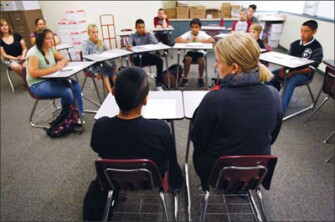
When 7th grader Danny Perez shoved and fought another 7th grader at Davidson Middle School in San Rafael, Calif., earlier this month, he had a choice.
The school could have suspended him for several days. Maybe he’d have cooled off. Or maybe the missed days of school would have been just the thing to stoke his anger and compel him to take on his classmate again.
We’ll never know.
Danny opted to have his case heard by the school’s peer court instead of being suspended. They asked him what he was thinking when he got into the fight. They devised ways to keep him busy at lunch—math and social studies tutoring—and after school—practicing with the wrestling and flag football teams—to deter him from another fight. They asked him to write a letter of apology to the teacher who had to break up the fight and another to his mother, who had to miss a day of work to observe the trial.
In addition, Danny will meet with the boy he fought to repair their relationship in a restorative circle, said Kristy Treewater, the school’s assistant principal.
Last week, Education Week kicked off a series of articles that look more closely at ways schools are trying to curb out-of-school suspensions, a practice that has been repeatedly shown to damage students’ academically and have little effect on their behavior in the long run. (You can see some of Education Week‘s other coverage of school discipline and climate all in one place now, too.)
“I thought this was genius,” Treewater said. The incident “stays very present, which is why we’re having so much success with peer court: [Students] are having this prolonged experience; it’s such a different type of learning.”
At Christian Fenger Academy High in Chicago, the school has created a web of alternative approaches to discipline, Principal Elizabeth Dozier said. School security officers have been trained in de-escalation techniques. Everyone in the building is trained in the kinds of restorative practices you’ll read about in the first story in the series.
“Conflict is human nature,” Dozier said. “We can resolve conflict peacefully. You cannot suspend or expel your way into greatness. You have to change behavior systematically.”
Suspensions and expulsions, she said, don’t seem to teach a whole lot of anything. “What have we taught them about being able to function in society?”
If forced to suspend a student, the school has a re-entry circle with the student and anyone else involved in the incident that led to the suspension.
Isn’t this a time-consuming approach, I asked her. “It’s a way of life,” Dozier said. “To me it would be more exhausting if I suspended the child for every infraction.”
PHOTO: Danny Perez, a 7th grader at Davidson Middle School in San Rafael, Calif., faces a court of his peers for getting involved in a fight. Kristy Treewater, the school’s assistant principal, sits by his side to monitor the student-run session. --Sarah Rice for Education Week